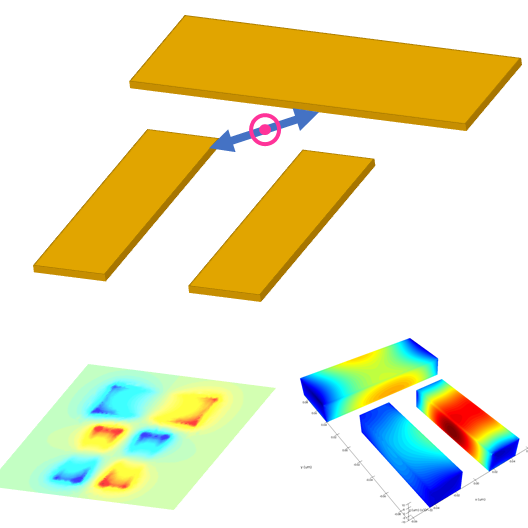- PRODUCTS
- SERVICES
- HARDWARE & IT
- LEARNING & DEVELOPMENT
- CADFEM INFORMS
CADFEM INFORMS OVERVIEW
- ABOUT US

Ansys Optics provides a comprehensive suite of simulation tools for designing, optimizing, and verifying optical systems. These tools are supported by world-class customer service and enable designers to accelerate the development of advanced optical products. With a range of high-fidelity physics solvers, Ansys Optics offers intuitive workflows for precise design across different scales, from nano to macro. This allows for the creation of diverse optical applications with improved performance, reliability, and yield.

Ensures precise material modeling across extensive wavelength ranges.

Ensures high accuracy, even with coarse meshes, due to its sensitivity to submesh geometry, enhancing simulation precision.

Accurately models heat flow in various geometries.

Zemax OpticStudio provides a comprehensive set of tools for optical design, analysis, and optimization, empowering engineers and designers to create high-performance optical systems for a wide range of applications.

Presenting SPEOS as an advanced optical simulation tool that designed specifically for camera and Lidar validation in real time. Its accuracy comes from precise ray tracing in which the light interacts with the optical components that helps the users to predict and improve the performance of the sensors.

SPEOS optimizes optical systems for VR, AR, and HUD, considering human vision factors. It ensures effective HUD interfaces in automotive, aviation and consumer electronics by integrating human vision capabilities. SPEOS also integrates AR and VR for prototyping and testing user experiences in gaming, training, and education.

SPEOS integrates with CAE tools, enabling comprehensive optical system design. Engineers assess performance by combining structural, thermal, electromagnetic evaluations with optical simulations. This ensures optimized designs for real-world applications, enhancing robustness, durability, and efficiency across industries.
Our platform excels in simulating opto-electronic devices, processes, and materials at the nano-scale. By solving Maxwell’s equations in the time domain, we offer a robust solution across a broad spectrum region, ensuring reliability and accuracy. It’s great for designing all sort of optoelectronic active and passive and materials. Plus, it gives accurate results across different light wavelengths. Also, it comes with tools that make it easier to write scripting, analyze results, and make designs better.
Ansys Mode is a powerful simulation tool that tackles the complexities of photonics with precision and efficiency. By solving Maxwell’s equations in the single frequency domain, it offers a comprehensive understanding of light behavior within waveguides and couplers. Its robust capabilities extend to accommodating large planar structures and lengthy propagation paths, ensuring accurate analysis across diverse scenarios. With bi-directional propagation, Mode accurately simulates guided light movement, capturing multiple reflections along the propagation direction for thorough insight. Additionally, its flexibility in handling variable device cross-sections enables detailed exploration of design variations. Through modal analysis, Mode delves deep into the modal behavior of photonics components, providing invaluable insights for optimizing performance and enhancing design efficiency.
The 2D/3D finite element Discontinuous Galerkin Time Domain (DGTD) solver stands at the forefront of electromagnetic simulation, offering unparalleled accuracy and efficiency. With its advanced capabilities, it enables the comprehensive analysis of electromagnetic phenomena across a broad spectrum of frequencies. Supported by broadband multi-coefficient material models, users can accurately represent the complex behavior of various materials, ensuring realistic simulation results.
This tool delivers precise outcomes for curved waveguide shapes and other complex geometries, thanks to its advanced capabilities. With higher-order mesh polynomials, it offers superior performance scalability, ensuring efficiency even with intricate structures. Users can easily model spatially varying index perturbations for electro-optic and thermo-optic analysis.
Interconnect offers a user-friendly interface with a vast library of basic and foundry-specific elements for schematic design. Users can incorporate measured data and component-level simulations to create and update calibrated Compact Model Libraries effectively. Additionally, it supports the publication of foundry Process Design Kits (PDKs) and seamlessly integrates with other popular EDA and PDA tools. With statistical capabilities like Monte Carlo and corner analyses, it ensures comprehensive design validation and optimization.
This tool conducts fully coupled quantum mechanical band structure calculations using the k.p method, ensuring accurate analysis of semiconductor materials. Integrated with INTERCONNECT, it facilitates the creation of advanced laser models, incorporating tuning and external feedback effects for comprehensive simulations. Its material library encompasses common III-V semiconductors, and it automatically generates models for fractional semiconductor alloys, streamlining the design process for semiconductor devices.
Zemax OpticStudio is a comprehensive software platform used for designing and analyzing optical systems. It’s widely used in industries such as aerospace, automotive, consumer electronics, and more, to design and optimize lenses, lighting systems, imaging systems, and other optical components. It allows engineers and designers to simulate and optimize the performance of optical systems before they are physically built, saving time and resources in the development process.
Ansys SPEOS is a powerful software suite designed for the design and validation of optical systems. It offers a scripting interface that allows users to replicate actions from the user interface, such as source creation and simulation result analysis, which can automate repetitive tasks. SPEOS also features direct modeling capabilities, enabling quick geometry definition without the complexity of traditional CAD software, making it accessible for non-CAD experts.


